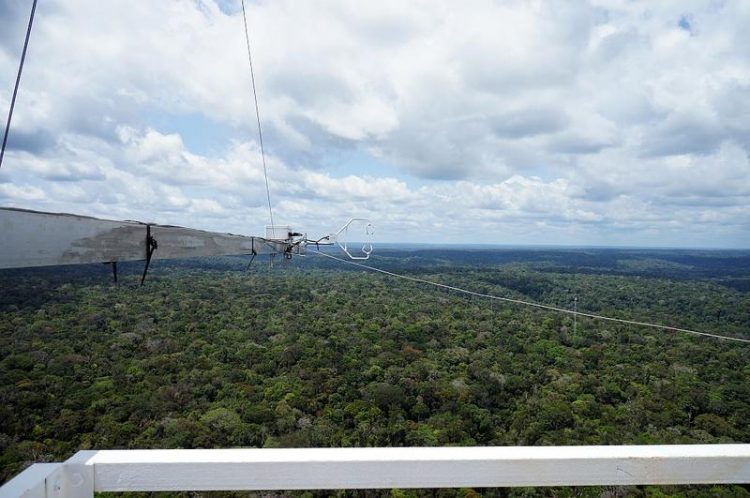Record growth in atmospheric CO2, in spite of stable anthropogenic emissions, due to weaker sinks

View of the Amazon rainforest in Brazil, a large terrestrial carbon sink, from the ATTO climate measurement tower. Picture by Jost V. Lavric, Max Planck Institute for Biogeochemistry
The high growth in atmospheric CO2 was mainly caused by a smaller uptake of carbon in the terrestrial biosphere in response to warm and dry conditions over tropical land. These unusual conditions were caused by the recent El Niño event that lasted from May 2015 to June 2016. In 2015, the land sink was smaller than usual at 7 [4 to 10] Gt CO2 per year, only 60% of its average intensity during the previous decade.
“What we see here is the response of land ecosystems to large interannual climate variability”, explains Dr. Sönke Zaehle from the Max Planck Institute for Biogeochemistry in Jena, Germany, who contributed model simulations to the study.
He continues, “on average, the land biosphere takes up carbon and slows the growth rate of atmospheric CO2, and will probably continue to do so for the next years. However, years like 2015 with a strong El Niño event should remind us that climatic swings with warmer temperatures and more droughts have a strong effect on the land carbon storage.”
The high in the atmospheric growth rate occurred despite the fact that global carbon emissions did not increase much anymore for the third year in a row. CO2 emissions from fossil fuels and industry did not grow in 2015 (at 36.3 Gt C per year), with world-average emissions per person at 4.9 t CO2 per year.
Professor Corinne Le Quéré, Director of the Tyndall Centre at University of East Anglia, UK, who led the data analysis, said: “This third year of almost no growth in emissions is unprecedented at a time of strong economic growth, and it is possible that the trajectory of global emissions has permanently deviated from the long-term growth trend.”
Verification of reported emissions cannot yet be done with independent data because of uncertainties in our capacity to account for carbon fluxes in the natural environment. The implication is that, at the moment, it could take 5-10 years before a peak in global CO2 emissions is confirmed with independent data.
Results presented here are published on November 14, 12.01 GMT, in:
Le Quéré, C., Andrew, R. M., Canadell, J. G., Sitch, S., Korsbakken, J. I., Peters, G. P., Manning, A. C., Boden, T. A., Tans, P. P., Houghton, R. A., Keeling, R. F., Alin, S., Andrews, O. D., Anthoni, P., Barbero, L., Bopp, L., Chevallier, F., Chini, L. P., Ciais, P., Currie, K., Delire, C., Doney, S. C., Friedling-stein, P., Gkritzalis, T., Harris, I., Hauck, J., Haverd, V., Hoppema, M., Klein Goldewijk, K., Jain, A. K., Kato, E., Körtzinger, A., Landschützer, P., Lefèvre, N., Lenton, A., Lienert, S., Lombardozzi, D., Melton, J. R., Metzl, N., Millero, F., Monteiro, P. M. S., Munro, D. R., Nabel, J. E. M. S., Nakaoka, S., O’Brien, K., Olsen, A., Omar, A. M., Ono, T., Pierrot, D., Poulter, B., Rödenbeck, C., Salisbury, J., Schuster, U., Schwinger, J., Séférian, R., Skjelvan, I., Stocker, B. D., Sutton, A. J., Takahashi, T., Tian, H., Tilbrook, B., van der Laan-Luijkx, I. T., van der Werf, G. R., Viovy, N., Walker, A. P., Wiltshire, A. J., and Zaehle, S.:
Global Carbon Budget 2016, Earth Syst. Sci. Data, 8, 605-649,
doi:10.5194/essd-8-605-2016, 2016.
http://www.earth-syst-sci-data.net/8/605/2016/
Media Contact
All latest news from the category: Earth Sciences
Earth Sciences (also referred to as Geosciences), which deals with basic issues surrounding our planet, plays a vital role in the area of energy and raw materials supply.
Earth Sciences comprises subjects such as geology, geography, geological informatics, paleontology, mineralogy, petrography, crystallography, geophysics, geodesy, glaciology, cartography, photogrammetry, meteorology and seismology, early-warning systems, earthquake research and polar research.
Newest articles

Properties of new materials for microchips
… can now be measured well. Reseachers of Delft University of Technology demonstrated measuring performance properties of ultrathin silicon membranes. Making ever smaller and more powerful chips requires new ultrathin…

Floating solar’s potential
… to support sustainable development by addressing climate, water, and energy goals holistically. A new study published this week in Nature Energy raises the potential for floating solar photovoltaics (FPV)…

Skyrmions move at record speeds
… a step towards the computing of the future. An international research team led by scientists from the CNRS1 has discovered that the magnetic nanobubbles2 known as skyrmions can be…




















